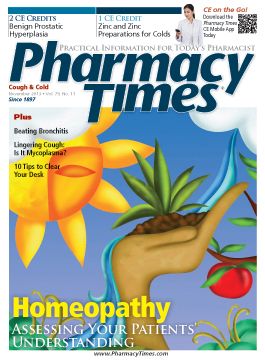Progress in Cancer-Associated Thromboembolism
Cancer patients must also contend with a range of accompanying maladies, including arterial and venous thromboembolism.

The American Cancer Society estimates that there will be 1,660,290 newly diagnosed cases of cancer by the conclusion of 2013. Taking the lives of almost 1600 people per day, cancer is the second-leading cause of death in the United States behind heart disease.1 These numbers are staggering, the affected population is widespread, and as such, this is an issue that touches the lives of most of us. The primary focus for these newly diagnosed patients is beating cancer. Beyond overcoming cancer, one must also conquer its accompanying maladies. Notably, the second-leading cause of death in patients with active malignancy is arterial and venous thromboembolism (VTE).2
The consequences of thromboembolic disease can be catastrophic without proper assessment and care. Patients receiving chemotherapy possess a 47-fold higher risk of dying of VTE over members of the general population.2 With thromboembolism becoming an increasingly common complication of cancer and treatment-related factors—including chemotherapy, hospitalization, and surgical interventions—it begs the question, how does one improve a cancer patient’s thromboembolic risk? Hypothesis, trial investigation, and evidence-based medicine have begun to shed a light on modern approaches to care.
Much discovery has occurred since Armand Trousseau’s observation of the link between malignancy and cancer in 1865.3 Insight into the connection between tumor biology, inflammation, and coagulation pathway activation has been gained. The meaning of Trousseau’s Syndrome has evolved with the greater understanding that tumor cells produce a variety of procoagulant factors, such as cysteine proteases and tissue factor, that release proinflammatory and proangiogenic cytokines. The upregulation of angiogenesis accompanied by the prothrombotic state in cancer leads to an aggressive tumor biology whereby cancer progression, metastasis, and mortality can result.
The CLOT Trial
The CLOT trial, which demonstrated a 52% reduction in the probability of symptomatic recurrent VTE, led us to the breakthrough that treatment with low-molecular-weight heparin (LMWH) monotherapy is superior to oral anticoagulation for patients with active cancer.4 Furthermore, as advancements are made to understand underlying mechanisms, there is some evidence that LMWH might have anti-angiogenic benefits in addition to the antithrombotic properties for which it is known.5
The risk of clot development is highest within the first 6 months after diagnosis. That said, risk is variable among the cancer population and can be stratified based on cancer-, treatment-, and patient-related factors. As a clinical assessment aid, a simple predictive model was developed to assess the risk of clot development using characteristics such as cancer site; readily available biomarkers such as platelet count, hemoglobin levels, and leukocyte count; and body mass index.6 With funding from the National Institutes of Health, this scoring tool has been validated to detect high-risk outpatients who may be suitable candidates for thromboprophylaxis.
Prophylactic Measures
It is well established that treatment and prophylaxis are efficacious in the noncancer population bearing risk of thrombosis; however, are prophylactic measures warranted and safe for use within the high-risk cancer population? Two of the largest studies to date, PROTECHT and SAVE-ONCO, assessed the use of anticoagulant prophylaxis in 1150 and 3212 ambulatory cancer patients with chemotherapy, respectively.7,8 Unfortunately, neither of the therapeutic options utilized is available for use within the United States. It is notable that extended prophylactic treatment may reduce the risk of thromboembolic events without an increase in major bleeding. Despite the significant reduction in VTE displayed within these trials, the event rates were not high enough for the clinical adoption of extended prophylaxis as a standard of care practice for high-risk patients.
Attention to prophylactic measures has heightened, and efficacy has been observed. Still, the American Society of Clinical Oncology Clinical Guideline 2013 Update does not recommend routine pharmacologic thromboprophylaxis in cancer outpatients. However, a new caveat—dissimilar from the former 2007 recommendations—is that clinicians may consider LMWH prophylaxis on a case-by-case basis in highly selected outpatients with solid tumors receiving chemotherapy.9 While the evidence is accumulating surrounding cancer-associated thrombosis in terms of its pathogenesis, risk assessment, and trial-related findings, it is important to apply the tools and knowledge acquired thus far to improve patient outcomes and quality of life in high-risk cancer populations. Proper application of these valuable achievements may positively impact the burden of VTE in cancer patients.
Dr. Stevens is an advanced practice anticoagulation pharmacist for the Partners Healthcare System and an adjunct clinical assistant professor of pharmacy at Northeastern University’s Bouvé College of Health Sciences in Boston, MA. This column’s information is based on current studies but may be updated without notice with newer studies or with different populations.
References
- American Cancer Society. Cancer Facts & Figures 2013. www.cancer.org/research/cancerfactsstatistics/cancerfactsfigures2013/index. Accessed October 30, 2013.
- Khorana AA, Francis CW, Culakova E, et al. Thromboembolism is a leading cause of death in cancer patients receiving outpatient chemotherapy. J Thromb Haemost. 2007;5:632-634.
- Trousseau A. Phlegmasia alba dolens. Clinique medicinale de l'Hotel-Dieu de Paris. London: The New Sydenham Society; 1865.
- Lee AY, Levine MN, Baker RI, et al. Low-molecular-weight heparin versus a coumarin for the prevention of recurrent venous thromboembolism in patients with cancer. N Engl J Med. 2003;349:146-153.
- Mousa SA, Petersen LJ. Anti-cancer properties of low-molecular-weight heparin: preclinical evidence. Thromb Haemost. 2009;102:258-267.
- Khorana AA, Kuderer NM, Culakova E, et al. Development and validation of a predictive model for chemotherapy-associated thrombosis. Blood. 2008; 111:4902-4907.
- Agnelli G, Gussoni G, Bianchini C, et al. Nadroparin for the prevention of thromboembolic events in ambulatory patients with metastatic or locally advanced solid cancer receiving chemotherapy: a randomised, placebo-controlled, double-blind study. Lancet Oncol. 2009;10(10):943-949.
- Agnelli G, George DJ, Kakkar AK, et al. Semuloparin for thromboprophylaxis in patients receiving chemotherapy for cancer. N Engl J Med. 2012;366(7):601-609.
- Lyman GH, Khorana AA, Kuderer NM, et al. Venous thromboembolism prophylaxis and treatment in patients with cancer: American society of clinical oncology clinical practice guideline update. J Clin Oncol. 2013; 31:2189-2204.

